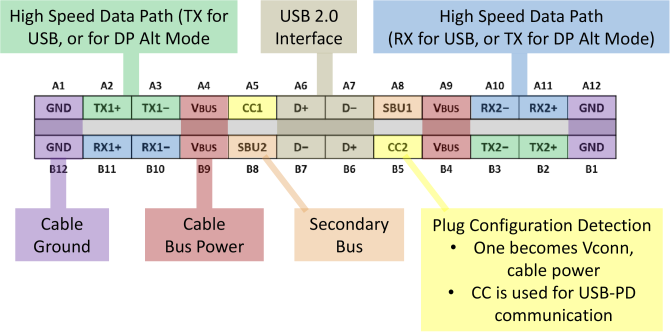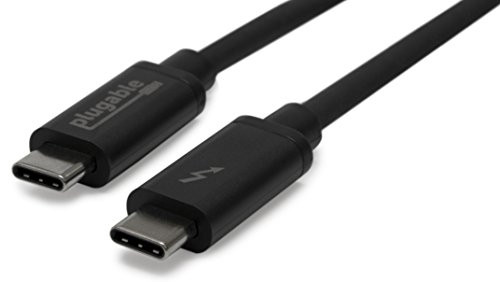The USB 3.0 Promoter Group has recently announced the upcoming USB 3.2 specification that defines multi-lane operation for compatible hosts and devices, hence doubling the maximum theoretical bandwidth to 20 Gbps.
Only USB Type-C cables were designed to support multi-lane operation, so other type of USB cables will not support USB 3.2, and stay limited to 10 Gbps. USB 3.2 will allow for up to two lanes of 5 Gbps, or two lanes of 10 Gbps operation, so if you want to achieve 20 Gbps transfer rate, you’ll need a USB Type C cable certified for SuperSpeed USB 10 Gbps, beside hosts and devices that comply with USB 3.2.

Anandtech explains that two high speed data paths are available in USB type C connector as shown above, which are also used for alternate modes, and the USB 3.1 standard makes use of one of those paths for 10 Gbps transfer, and the other path for alternate mode, but USB 3.2 allows for both to be used for 10 Gbps transfers hence achieving up to 20 Gbps. If both paths are used for alternate modes, then transfers will be limited to USB 2.0 speeds (up to 480 Mbps).
That’s a good development, but it will be further be confusing to consumers, as most companies do not clearly explain the capabilities of their USB type C interfaces or/and cables. USB type C cables can be made for USB 2.0 (480 Mbps), USB 3.0 / USB 3.1 Gen 1 (5 Gbps), or USB 3.1 Gen 2 (10 Gbps), and only the latter will support USB 3.2.

Jean-Luc started CNX Software in 2010 as a part-time endeavor, before quitting his job as a software engineering manager, and starting to write daily news, and reviews full time later in 2011.
Support CNX Software! Donate via cryptocurrencies, become a Patron on Patreon, or purchase goods on Amazon or Aliexpress






Finally, we can see some real External USB graphic cards
displaylink works quite nicely, specially over thunderbolt 3
I think this is an obvious evolution of the standard as it uses cables already available and introduces no new electrical complexity–higher/different signaling rate, etc.
I really this and the increased prevalence of TB as a USB3 ALT mode will push Intel to put more PCI-E links on their mobile chipsets. Heck, their normal DT chipsets could use some more as well.
@willmore
Existing cables can’t exceed 1m in length for this new mode and TB is not really an USB3 alternative mode 😉
@tkaiser
Actually, this standard allows a dual-5GBs mode which would allow USB3.2 to USB3.2 devices with type C connectors to do 10GBs at 2m–twice what a USB3.1 gen2 set of devices could do.
And okay, TB3 isn’t strictly an alt-mode, but it shares ports with USB3.1 gen 2 type C so the controller for that port needs to BW to support TB3 and the PCI-E links to back that have been problematic as Intel mobile chipsets are weak in that respect. If they want to support USB3.2 on all of their ports, they’re going to need to increase the number of PCI-E lanes–even for the non-TB chipsets simply because each USB3 type-C port just got twice as PCI-E ‘expensive’.
@willmore
We all should stop talking about USB version numbers (the ‘USB3.1 gen2’ stuff) but instead use the correct naming: SuperSpeed, SuperSpeed+ and whatever these 2 USB lane modes are called now (I wait until USB 3.2 specs are published to look more into this). We should also keep in mind that SuperSpeed with 5 Gbps signaling rate is insanely inefficient compared to SuperSpeed+ since it’s 8b/10b vs. 128b/132b encoding: That’s 4 GB/s with SuperSpeed vs. almost 10 GB/s with SuperSpeed+. No idea whether USB 3.2 specs will use 128b/132b encoding for 2 lane 5 Gbps mode or 8b/10b (8 GB/s vs. 10 GB/s).
Wrt relationship between USB and PCIe lanes: On the MacPro for example all the 4 USB3 ports are provided by a single Fresco Logic FL1100 chip which is x1 PCIe 2.x attached so they have to share bandwidth unlike on all other Macs built since 2012. And as soon as we see ‘USB 3.2 capable’ devices being advertised we can be sure that while they might implement dual lane USB operation they will be crippled anyway (there will be bridge chips providing USB 3.2 using just a single PCIe 2.x lane to the CPU since consumers buy numbers and don’t give a sh*t about real performance)
we should ignore it really cos usb 2 is still on too many products
will be about 2030 before it comes on all things
Well, I can confirm that switching on my brain before doing any purchases really helps avoiding crappy products. It’s easy, you should try it too!
I would prefer seeing USB-C already everywhere since the connector alone is such an improvement compared to the Micro USB and USB3-A crap we’re dealing now with.
@Alejandro M
Are you talking about DisplayPort (part of TB since the very beginning) or about this proprietary DisplayLink stuff here: http://www.cnx-software.com/2017/02/03/targus-universal-displaylink-docking-stations-support-up-to-six-4k-monitors-via-a-single-usb-cable/
USB 3.2 specifications released @ http://www.usb.org/developers/docs/usb_32_092217.zip